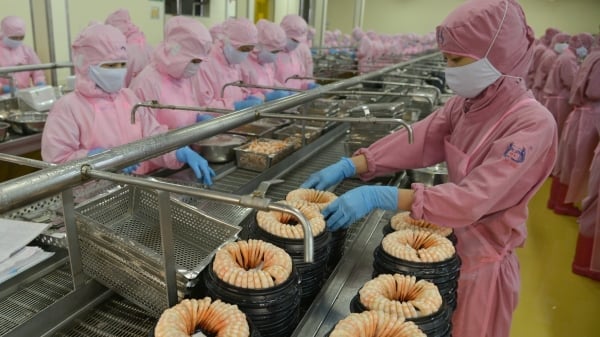November 28, 2025 | 06:40 GMT +7
November 28, 2025 | 06:40 GMT +7
Hotline: 0913.378.918
November 28, 2025 | 06:40 GMT +7
Hotline: 0913.378.918

Japan's maximum acceptance threshold for the Doxycycline indicator in imported seafood is 10 times stricter than the maximum acceptance thresholds of many other markets.
According to the Vietnam Association of Seafood Exporters and Producers (VASEP), reflections of businesses exporting shrimp to the Japanese market show that there is currently a major inadequacy related to the Doxycycline antibiotic indicator in seafood imported into Japan.
Specifically, regarding the Doxycycline antibiotic indicator, Japan's regulation is said to be "too strict" compared to the acceptance thresholds of many other markets. This is causing great difficulties and disadvantages for Vietnamese seafood exports to Japan because this antibiotic is still allowed to be used in aquaculture in Vietnam.
According to preliminary research by VASEP and businesses, currently, many markets do not ban the use of the Doxycycline antibiotic (belonging to the Tetracycline group) in aquaculture and do not test the residue of this antibiotic in farmed aquatic products imported.
Some markets, such as the EU, China, and New Zealand, test this indicator, but all stipulate the allowable maximum residue limit (MRL) of 100 ppb. This is considered an appropriate level, with a risk assessment, that Vietnam's strictly controlled farmed seafood can fully meet.
However, Japan has only regulated the MRL level of Doxycycline in products of the Perciformes ordo at 50 ppb and has not regulated the MRL level for other aquatic products. According to Japan's current regulations, for chemical and antibiotic indicators, there is no MRL-level regulation on a general limit of 10 ppb (Uniform limit) that will be applied to these indicators. This means that Japan's maximum acceptance threshold for the Doxycycline indicator in imported seafood is 10 times stricter than the maximum acceptance thresholds of many other markets.
Therefore, VASEP has just sent an official dispatch to the Ministry of Agriculture and Rural Development, requesting the Ministry to consider and give opinions to Japanese authorities so that the Japanese side can issue regulations on the allowable maximum limit (MRL) for the Doxycycline antibiotic that is equal to the level of other markets such as the EU, China, and New Zealand.
Japan has been one of Vietnam's three largest seafood import markets for many years. In 2023, Japan was the second-largest market for Vietnamese seafood, with a seafood export value to this market of USD 1.516 billion.
Translated by Thu Huyen

(VAN) China’s cooking oil is suddenly flooding into India. It all comes down to a soybean surplus that Beijing doesn’t quite know what to do with.

(VAN) An Giang promotes supply-demand connections, standardizes quality and builds value chains, creating a foundation for sustainable bird’s nest development and aiming to expand exports.
/2025/11/24/5339-4-nongnghiep-075331.jpg)
(VAN) Recently, the conference on 'Sustainable Fisheries Linkage Chain - Tilapia for Export' took place in Tien Hai commune, Hung Yen province.
/2025/11/21/4309-2-153400_128.jpg)
(VAN) Green and low-emission rice is paving the way for Vietnamese rice to enter high-end markets, marking the beginning of a transformation journey toward greening and elevating the national rice brand.

(VAN) ‘Right to Win’ outlines a national action plan that shapes a new vision for Viet Nam’s agriculture in an era of renewal and global integration.

(VAN) Lam Dong’s farmed sturgeon output this year is expected to reach 2,300 tons, worth VND 450 billion, affirming the brand’s position on the market.

(VAN) A surge in Ukrainian egg exports, largely driven by soaring sales to the UK over the last few years, has notably pushed up egg prices on the domestic market.